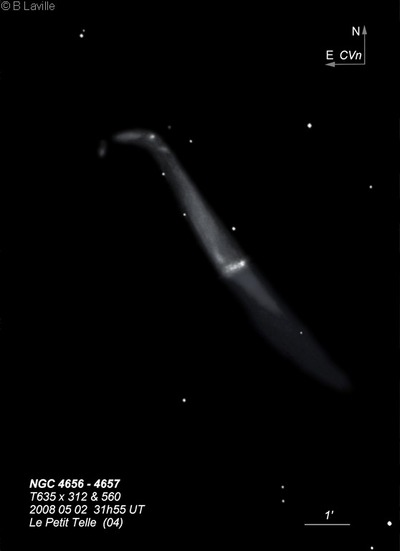
William Herschel discovered NGC 4656 = H I-176 = h1414, along with NGC 4657, on 20 Mar 1787 (sweep 722) and recorded "Two, their nebulosity join; they are both elongated and together form the shape of the letter "S". The most south [NGC 4656] cB, mbM. The most north NGC 4657], pB from sp to nf, but very near the meridian. John Herschel made a total of 5 observations. In sweep 342 he noted, "a long nebulous ray pos = 34.3° (by micrometer). Its southern half is fainter than its northern. It meets and cuts? another nebula NGC 4657]. A strange object." A sketch was published in plate 15, Figure 75 in his Slough Observations.
Bindon Stoney sketched the pair at Birr Castle on Apr 26 1851 (included in LdR's 1861 publication). The following year he called this pair "like a caterpillar on a leaf."
300/350mm - 13.1" (4/10/86): striking!, fairly bright, very elongated SW-NE. Appears wider and brighter at the SW end. The NE end hooks sharply east to merge with NGC 4657 which may be a part of NGC 4656 and not a separate galaxy. A star or knot is attached at the south end. Appears like a celestial hockey stick!
400/500mm - 18" (5/14/07): this fascinating galaxy forms one of the most striking pairs in the sky with NGC 4631 32' NW. At 220x, the distorted shape extends ~9'x1.5' in a SW-NE orientation. On first glance, it appears the bulging core is offset at the SW end, though with averted vision a very low surface brightness broader extension continues to the the SW of the core for several arcminutes before fading into the background. The core is very bright and mottled with a bright knot (HII region) jutting out to the west at the southwest end of the core. The NE extension has a remarkable, fairly bright 2' extension (NGC 4657), hooking to the east at a 45° angle from the major axis (the "blade" of the hockey stick). There is a small, faint, detached knot beyond the east end of the "blade" that appears to have broken off. The unusual bend and knot at the NE end is a result of a prior tidal interaction with its more massive neighbor, NGC 4631.
900/1200mm - 48" (4/23/17): this showpiece galaxy was viewed at 375x and 488x and the structure/details was very comparable to the POSS2. The galaxy extended ~8'x1' SW-NE, though it has a much lower surface brightness on the SW end. It is well concentrated with a very bright and large, elongated core on the south end of the brighter half, giving a very asymmetric appearance. A bright stellar or quasi-stellar knot is at the southwest edge of the core (this is a huge star cloud on the HST image identified in SIMBAD as [BKD2008] WR 462, from a 2008 paper on Wolf-Rayet features). A faint (17th mag?) stellar object is close east.
The low surface brightness southwest portion of the galaxy to is broader than the northeast section. It includes a faint, quasi-stellar knot (identified in SIMBAD as CasHII N4656a, from a 1984 Case University survey of HII regions in blue galaxies) along the western edge with a SDSS magnitude of 17.8V.
At least 4 main HII complexes are at the northeast end of the galaxy (NGC 4657), including a separate detached section. On the southwest edge is a bright knot, ~8" diameter, catalogued in SIMBAD as CasHII N4656f and in NED as NGC 4656:[DBT2008] 85 from a 2008 paper on massive clusters. A brighter 10" knot, identified in NED as 2MASX J12440599+3212340, is ~20" N, also along the west edge of the NE extension. The northeast end of the galaxy (NGC 4657) has a sharp extension to the east with a slightly brighter patch, identified in NED as 2MASX J12440844+3212340. Finally a bright, elongated patch ~30"x15" oriented NNW-SSE is detached to the east. SIMBAD identifies this object as(NGC 4657, though the NGC designation should probably apply to the entire bent NE end of the galaxy.
Notes by Steve Gottlieb